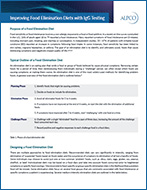Improving Food Elimination Diets with IgG Testing
Purpose of a Food Elimination Diet
Food sensitivity or food intolerance involves a non-allergic response to a food or food additive. In a recent on-line survey conducted in the U.S., 24% of adults aged 18 to 79 reported a food intolerance. Many reported symptoms of food intolerance are GI-related, including stomach pain, bloating, and diarrhea or constipation. In independent studies, 20 - 67% of patients with irritable bowel syndrome (IBS) reported an increase in symptoms following food intake. In some instances, food sensitivity has been linked to skin rashes, migraine headaches, or asthma. The goal of an elimination diet is to identify, and ultimately avoid, foods that cause distressing symptoms and negatively impact quality of life.1,2,3,4,5
Typical Outline of a Food Elimination Diet
An elimination diet is an eating plan that omits a food or group of foods believed to cause physical symptoms. Removing certain foods for a period of time, then reintroducing them individually during a “challenge” period, can often reveal which foods are causing symptoms or making them worse. An elimination diet is one of the most widely-used methods for identifying problem foods.
Download the Article: Improving Food Elimination Diets with IgG Testing





